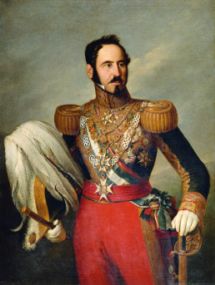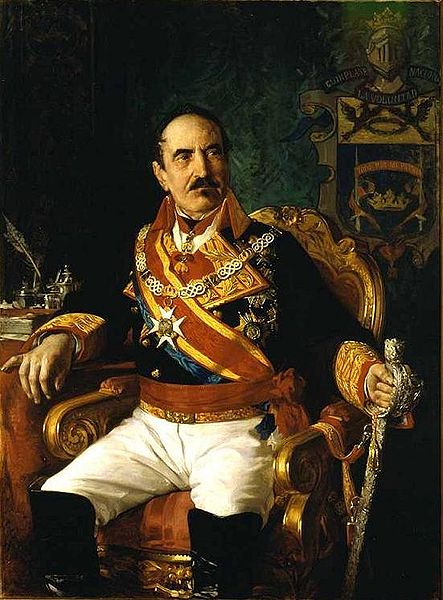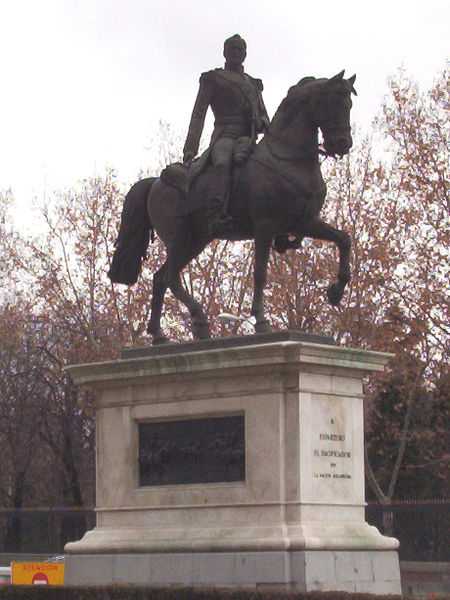<Back to Index>
- Physicist Yulii Borisovich Khariton, 1904
- Composer Charles Hubert Hastings Parry, 1848
- General of the Spanish Army Joaquín Baldomero Fernández - Espartero y Alvarez de Toro, 1793
PAGE SPONSOR



Don Joaquín Baldomero Fernández - Espartero y Alvarez de Toro, 1st Prince of Vergara, 1st Duke of la Victoria, 1st Duke of Morella, 1st Count of Luchana, 1st Viscount of Banderas (27 February 1793 – 8 January 1879) was a Spanish general and political figure. He was associated with the radical (or progressive) wing of Spanish liberalism and would become their symbol and champion after taking credit for the victory over the Carlists in 1839. His noble titles, Duke of La Victoria were granted by Isabella II to him as a result. The title Prince of Vergara was granted to him by King Amadeo of Spain in 1870.
Espartero was born at Granátula de Calatrava, a village of the province of Ciudad Real. He was the ninth child (two of them were Francisco and Antonia) of Manuel Antonio Fernández - Espartero y Cañadas, a carter, who wanted to make him a priest, and wife Josefa Vicenta Alvarez de Toro y Molina, but the lad at fifteen enlisted in a battalion of students to fight against the armies of Napoleon. In 1811 Espartero was appointed a lieutenant of engineers in Cádiz, but having failed to pass his examination he entered a line regiment. In 1815 he went to South America as a captain under General Morillo, who had been made commander - in - chief to quell the risings of the colonies on the Spanish Main. For eight years Espartero distinguished himself in the struggle against the colonists. He was several times wounded, and was made major and colonel on the battlefields of Cochabamba and Sapachni. He had to surrender to Sucre at the final Battle of Ayacucho, which put an end to Spanish rule. He returned to Spain, and, like most of his companions in arms, remained under a cloud for some time. He was sent to the garrison town of Logroño, where in La Rioja he married on 13 September 1827 the orphaned daughter of a rich landowner named Ezequiel Martínez de Sicilia y Ruíz de la Cámara (1786 – 1812) and wife María del Carmen Anacleta Santa Cruz y Oribe (1786 – 1816), Doña María Jacinta Martínez de Sicilia y Santa Cruz, born there on 16 August 1811 and who eventually survived him, dying in 1878, without issue. Henceforth Logroño became the home of the most prominent of the Spanish political generals of the 19th century.
Espartero became, on the death of King Ferdinand VII in 1833, one of the most ardent defenders of the rights of his daughter, Isabella II. On the outbreak of the First Carlist War, the government sent him to the front as commandant of the province of Biscay, where he severely defeated the Carlists in many encounters. He was quickly promoted to a divisional command, and then made a lieutenant general. At times he showed qualities as a guerrillero quite equal to those of the Carlists, like Zumalacarregui and Ramón Cabrera, by his daring marches and surprises. When he had to move large forces he was greatly superior to them as an organizer and strategist, and he never disgraced his successes by cruelty or needless severity. Twice he obliged the Carlists to raise the siege of Bilbao before he was appointed commander - in - chief of the northern army on 17 September 1836. At this time, the tide of war seemed to be setting in favor of the pretender in the Basque provinces and Navarre, even though Don Carlos had lost his ablest lieutenant, the Basque Zumalacarregui.
His military duties at the head of the principal national army did not prevent Espartero from showing for the first time his political ambition. He displayed such radical and reforming inclinations that he laid the foundations of his popularity among the lower and middle classes, which lasted more than a quarter of a century, during which time the Progressists, Democrats and advanced Liberals always looked to him as a leader and adviser. In November 1836 he again forced the Carlists to raise the siege of Bilbao. His troops included the British legion under Sir de Lacy Evans. This success turned the tide of war against Don Carlos, who vainly attempted a raid towards Madrid, but was defeated in the Battle of Aranzueque. Meanwhile, on 18 June 1837 he was nominated for the first time the 7th Prime Minister of Spain, until 18 August 1837.
Espartero was soon at his heels, and obliged him to hurry northwards, after several defeats. Espartero won the Battle of Ramales on 12 May 1839, earning him the title of Duke de la Victoria.
In 1839 Espartero carefully opened up negotiations with Maroto and the principal Carlist chiefs of the Basque provinces. These ended in their accepting his terms under the convention of Vergara,
which secured the recognition of their ranks and titles for nearly 1,000
Carlist officers. Twenty thousand Carlist volunteers laid down
their arms at Vergara; only the irreconcilables led by Cabrera held out
for a while in the central provinces of Spain. Espartero soon, however,
in 1840, stamped out the last embers of the rising, which had lasted
seven years. He was styled El pacificador de España, was made a grandee of the first class, and received two dukedoms.
It was against this backdrop that Espartero's political opponents, the moderates, mobilized support to amend the progressive Constitution of 1837. In particular, the moderates' proposal to abolish democratically elected local councils threatened to destroy the power base of the progressives. This threat was checked by the radical revolution of 1840, after which the conservatives were sidelined and Espartero became the master of the destiny of Spain.
During the last three years of the war, Espartero, who had been elected a deputy, exercised from his distant headquarters such influence over Madrid politics that he twice hastened the fall of the cabinet, and obtained office for his own friends. At the close of the war the queen regent and her ministers attempted to elbow out Espartero and his followers, but a pronunciamiento ensued in Madrid and other large towns which culminated in the marshal's accepting the post of prime minister. He soon became virtually a dictator, as Queen Christina took offense at his popularity and resigned, leaving the kingdom very soon afterwards. Directly the Cortes met and they elected Espartero regent by 179 votes to 103 over Argüelles, who was appointed guardian of the young queen.
Forcing the regent, Maria Cristina,
into exile for her conspiracy with the moderates, Espartero himself
became regent with the intention of remaining so until the future Queen Isabella II came
of
age. Espartero's popular support enabled him to crush moderate military
uprisings across Spain in 1841. Yet his ruthless execution of
dozens of the conspirators, including many popular fellow war heroes
like Diego de Leon, as well as his hasty and ungrateful dissolution of the radical juntas that had crushed the risings, marked the start of the decline in support for his regency.
For two years Espartero ruled Spain, as its 18th Prime Minister from 16 September 1840 to 21 May 1841, in accordance with his radical and conciliatory dispositions, giving special attention to the reorganization of the administration, taxation and finances, declaring all the estates of the church, congregations and religious orders to be national property, and suppressing the diezma, or tenths. He suppressed the Republican risings with as much severity as he did the military pronunciamientos of Generals Concha and Diego de León. The latter was shot in Madrid. Espartero crushed with much energy a revolutionary rising in Barcelona, but on his return to Madrid was so coldly welcomed that he perceived that his prestige was on the wane. An economic slump and rumors of a free trade deal with Britain provoked a popular uprising by workers and the bourgeoisie of Barcelona in 1842. Espartero's ruthless bombardment of the city crushed this revolutionary threat. But a second uprising in 1843, combined with moderate conspiracies and military uprisings. The rebels declared Queen Isabella of age, and, led by General Ramón María Narváez y Campos, marched upon Madrid. Espartero, deeming resistance useless, embarked at Cadiz on 30 July 1843 for England, and lived quietly apart from politics until 1848, when a royal decree restored to him all his honors and his seat in the senate. Dubbed public enemy number one by the brutal forces of reaction, headed by the moderate Narváez, Espartero was unable to return to his estates in northern Spain until an amnesty was decreed later in the 1840s.
Although Espartero's regime (1840 – 1843) in reality had done little for Spain's poor, the anti - radical reaction of the moderates made the former regent a folk hero amongst many of the workers. Therefore, it was logical that he should become head of the short lived "progressive Biennium" of 1854 – 1856, thus becoming the 43rd Prime Minister of Spain on 19 July 1854. But, as Karl Marx observed, the progressive caudillo was a man whose time had passed. The old marshal vainly endeavored to keep his own Progressists within bounds in the Cortes of 1854 – 1856, and in the great towns, but their excessive demands for reforms and liberties played into the hands of a clerical and reactionary court and of the equally retrograde governing classes. The growing ambition of General O'Donnell constantly clashed with the views of Espartero, until the latter, in sheer disgust, resigned his premiership and left for Logroño, after warning the queen that a conflict was imminent between O'Donnell and the Cortes, backed by the Progressist militia. O'Donnell's pronunciamiento in 1856 put an end to the Cortes, and the militia was disarmed, after a sharp struggle in the streets of the capital. Spanish political power swung once more back towards the moderates in 1856.
He was the 42nd Grand Cross of the Order of the Tower and Sword.
After 1856 Espartero resolutely declined to identify himself with active politics, though at every stage in the onward march of Spain towards more liberal and democratic institutions he was asked to take a leading part. On 14 July 1858 he resigned as Prime Minister. He refused to allow his name to be brought forward as a candidate when the Cortes of 1868, after the Revolution, sought for a ruler. Espartero, strangely enough, adopted a laconic phrase when successive governments on their advent to power invariably addressed themselves to the venerable champion of liberal ideas. To all to the Revolution of 1868, the Constituent Cortes of 1869, King Amadeus, the Federal Republic of 1873, the nameless government of Marshal Serrano in 1874, the Bourbon restoration in 1875 he simply said: Cumplase la voluntad nacional (Let the national will be accomplished). King Amadeus made him prince of Vergara. The Restoration raised a statue to him near the gate of the Retiro Park in Madrid. Spaniards of all shades, except Carlists and Ultramontanes, paid homage to his memory when he died at his La Rioja residence on 8 January 1879. His tastes were singularly modest, his manners rather reserved, but always kind and considerate of humble folk. He was a typical Spanish soldier - politician, though he had more of the better traits of the soldier born and bred than of the arts of the statesman. His military instincts did not always make it easy for him to accommodate himself to courtiers and professional politicians.
He died without issue and was succeeded in his titles by his niece Eladia Fernández - Espartero y Blanco, 2nd Duchess of la Victoria and 2nd Countess of Luchana, daughter of his brother Francisco Fernández - Espartero y Alvarez de Toro.